Contents
- How Do I Know if My Golden Retriever Is Experiencing Separation Anxiety?
- Top 7 Signs of Separation Anxiety in Your Golden Retriever
- Why Do Dogs Experience Separation Anxiety?
- How Can I Comfort My Golden Retriever to Stop Separation Anxiety?
- Can You Discipline Your Golden Retriever to Stop Separation Anxiety?
- Golden Retriever Separation Anxiety Can be Easy to Fix
Golden Retrievers are one of the most wonderful dog breeds, and they make great family pets. These are friendly, outgoing, and enthusiastic dogs who love almost everything about life and everyone they meet. They make great companions for children, and they are always happy to enjoy a walk, a hike, or playing fetch with their owners.
Sometimes Golden Retrievers can experience separation anxiety. This is not a condition that impacts all Golden Retriever dogs, but it is more common in high-drive dog breeds. When your dog is experiencing separation anxiety, they might escape the backyard, chew up items in your home, or even have accidents in the house while you are away.
If you have a dog that is displaying signs of this anxious behavior, you might be really worried about them. Thankfully, there are some key symptoms to look for and some really effective tactics to help you to treat the problem before it gets out of hand.
How Do I Know if My Golden Retriever Is Experiencing Separation Anxiety?
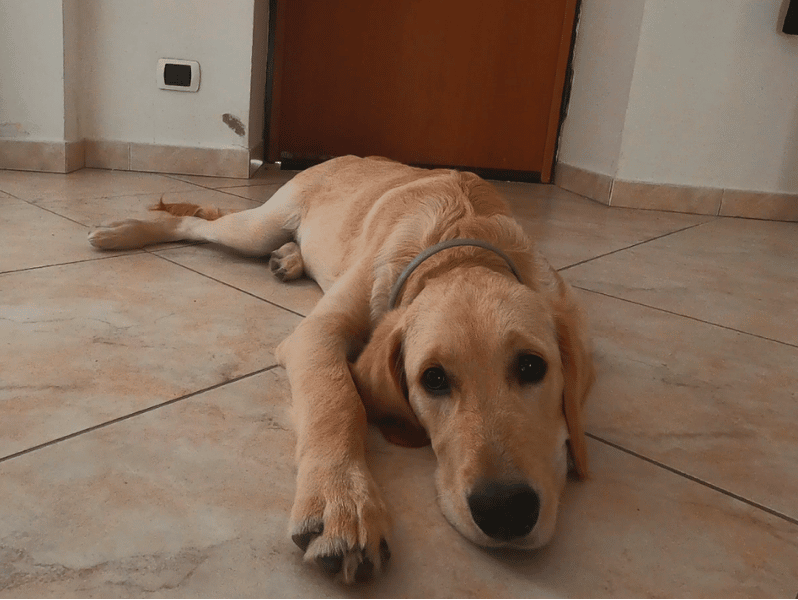
Separation anxiety is one of the most frustrating conditions for owners to deal with. When you do not know how to handle this anxious behavior, your dog can be destructive, experience health issues, and be impossible to leave at home when you need to run errands. Dogs with separation anxiety can also be hard to leave behind when you head out for vacation or work trips.
There are some key signs that your dog is experiencing this anxious condition, and you need to be on the lookout for them if you think that your dog might be starting to display separation anxiety. When you are paying attention to the kinds of behaviors that you are seeing, you can more accurately diagnose your dog with this issue and then start working on treatment.
Top 7 Signs of Separation Anxiety in Your Golden Retriever
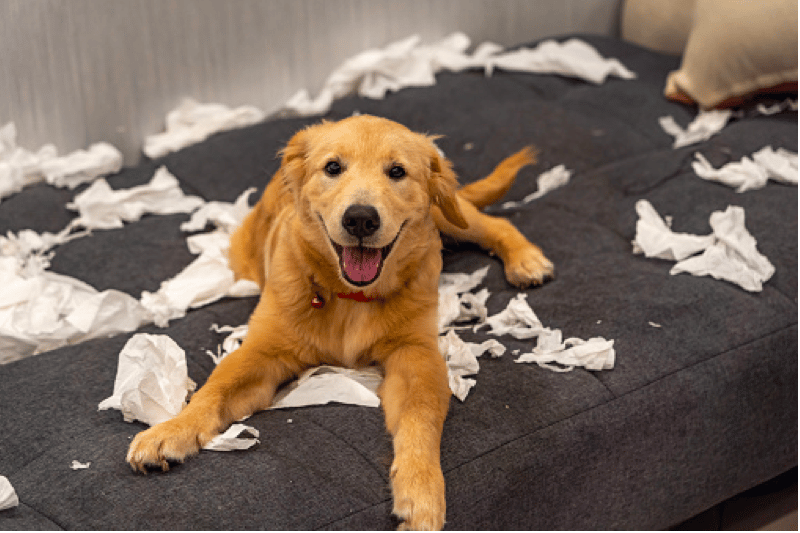
- Howling, barking, or whining in excess of normal
- Having accidents in the house
- Chewing up or destroying things
- Drooling, panting, and pacing
- Breaking through doors or scratching at surfaces or the sides of their crate
- Escaping bedrooms, backyards, or other spaces
- Pacing obsessively
Many dogs that display separation anxiety behaviors will start out being all right part of the time when their owner goes away. Over time, symptoms can escalate and become very overwhelming to deal with. This is one of the most common reasons for people dropping dogs off at the shelter or giving them away to new owners.
Often dogs that have separation anxiety can actually be trained to handle being alone gracefully. This is a process that can take some time, but a trainer can help you create a training plan for your pet that will generate big improvements. There are many ways to try and make your dog more comfortable with their time away from you as well, and you could exhaust these ideas before you seek the help of a professional if you want. Caring for a dog with separation anxiety can actually be easier than you might think.
Why Do Dogs Experience Separation Anxiety?

The root of separation anxiety is the DNA of dog social structures. Dogs are pack animals, meaning that they feel safest and happiest when they are not alone. They view their owners as part of their pack, and their DNA drives them to remain with the pack when in doubt. More confident individuals probably worry when their owners are not home, but they are able to refrain from giving in to anxious behavior when left in the house on their own.
Dogs that are less confident might feel very frightened when they are left alone and do everything in their power to get back to their pack. This is like a biological imperative, and that is why this behavior can be so hard to treat and prevent. While many people believe that selective breeding should have removed these drive-in domestic dogs, there are pets that still feel very driven to engage in a pack social structure.
When you own a dog that lives alone, you are the only social group that they have access to in order to make sense of their world. When you leave, this can lead to disorientation on the part of a dog that clings tightly to this pack mentality for comfort. This is one of the most misunderstood reasons behind separation anxiety, and the confusion about why the behavior is happening can lead to discipline and other management methods that are not effective.
Separation anxiety can be common in elderly dogs as well because their memory can be failing. These dogs might not remember, based on prior experience, that their owners leave and come back all the time. This can be a surprise to people who own a dog that has never exhibited this behavior before and is suddenly showing symptoms in old age.
How Can I Comfort My Golden Retriever to Stop Separation Anxiety?
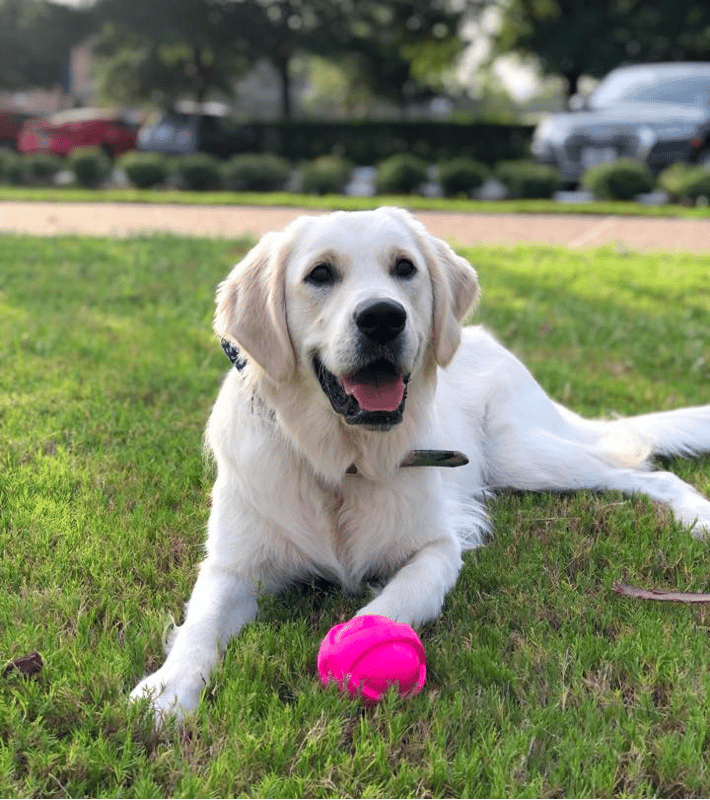
There are various ways that you can tackle the problem of separation anxiety. Each dog responds to these solutions differently, so you might have to try a few different treatments before you find the right one for your dog’s needs. Understanding if there are secondary causes for the behavior can be important as well. For example, separation anxiety that has started due to the death of a companion pet can be a very different problem to treat than puppy separation anxiety.
When you tailor the solution that you employ to your pet’s unique needs and personality, you will have better luck overall with the resolution of the problem. Always remember not to get frustrated with your pet. They cannot help it that they are afraid when you leave them alone. Being frustrated with them will only make them more upset and more likely to display unwanted behavior.
1. Provide Distraction
When your dog is young, or they are only mildly anxious when you leave, you can help them to focus on other things by giving them a toy that will keep them busy. This might be a Kong that is filled with peanut butter, or you might want to put on some music or white noise to help them with sound-related worries.
Dogs that have something to do when they are home alone will be much less likely to be upset and start getting into things and destroying things. For dogs that chew when they are left alone, you will want to provide access to toys that can hold up to this demand. Offering a toy that will be broken and ripped up right away will not help your dog to entertain itself for the whole time that you are gone.
You will also want to be wary of offering up food as a distraction, as it can be easy to make your dog obese this way. You should also steer clear of rawhide chews as they can lead to blocked intestines and choking. If you are not sure about which kind of food-based toy to offer to your dog, ask your vet what they recommend. There are many toys on the market that are safe for chewing, and that will not cause a medical emergency while you are away from home.
2. Consider a Companion
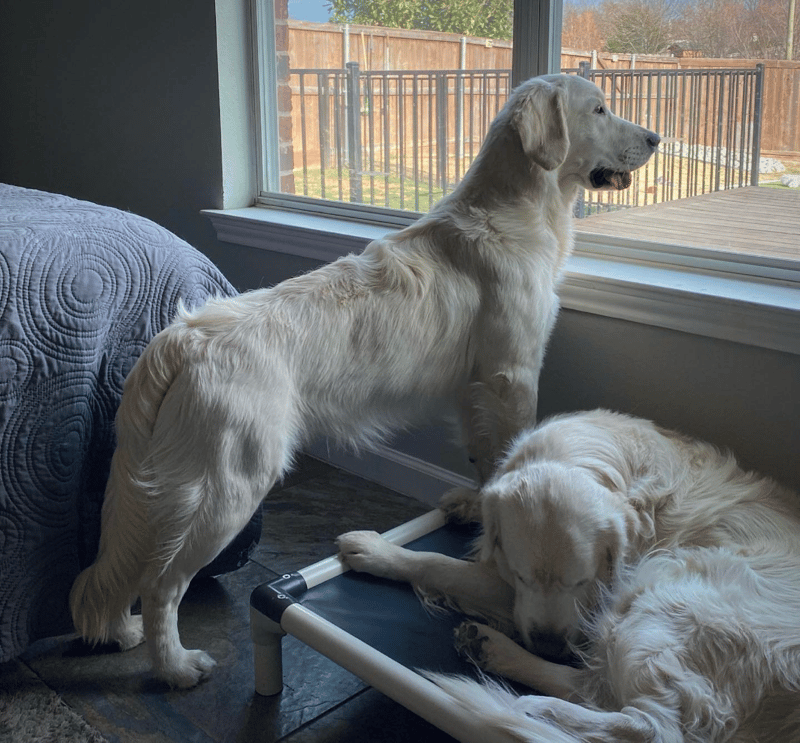
Sometimes dogs just need to have a friend who will be home with them when you are not there. Some people find that even adding a cat to the home makes their dog feel less alone and helps with separation anxiety. You might need to consider getting a second dog so that your first dog can be happy and feel safe when you are away.
Companion situations are often the most effective when you have a timid dog that is worried about being without its pack in other situations as well. You will need to pick the companion dog carefully, however, so that there are no fights and other issues when you are not around to supervise. An older dog might not be the best solution for this need as they will be more set in their ways.
Make sure that you try integrating any new animal with your existing pet before you commit to adding this new pet to your home. You can create just as many new problems trying to solve the separation anxiety issue if you are not careful. Picking the right companion can make a big difference for many pets that suffer from separation anxiety, and this might be the perfect solution for your needs.
3. Visit the Vet
Sometimes anxiety in dogs is so severe that it cannot be treated without the help of your vet. When you feel that you have tried everything without success, you can take your dog to the vet for some further help with the problem. There are many mild yet effective medications on the market that your vet can prescribe for your dog that gets separation anxiety.
Armed with some help of this nature, you can help train your dog to feel safe when you are not home. You can also pair this kind of help with items like a thunder shirt. Thunder shirts work by pressing against your dog’s sides and tapping into the nurturing they remember from when they were a puppy. This sense of being cradled reminds dogs of the hugging nature of being with their siblings when they are not fully grown. For many dogs, this is a big help when anxiety strikes.
You might not want to address your dog’s condition with synthetic medications, but there are also all-natural ways to create a calming reaction in your pet. Your vet should be able to advise about the best ways to use these tactics to help with anxious behaviors of all kinds.
4. Invest in a Crate
While many people think that crates are mean and make dogs feel trapped, the opposite is true in most cases. Many dogs actually really do feel safer in small spaces. This is because dogs den up when they are in the wild so that they can reduce the chance that they will be surprised by a threat while they are resting or eating.
While some dogs do not like crates, many dogs will feel much safer in this smaller space when you are gone. You should make sure that the crate is not big enough that your dog can pace and make sure that you pick one that has a top and is fully enclosed. You will also want to consider putting a towel over the front of the crate to keep your dog from worrying about things it can see outside its crate.
Dogs might cry a little when you first put them into the crate, but they will quickly calm down and just go to sleep. This is a really good tool for instilling patience, a calm state of mind, and preventing chewing behaviors that can lead to medical emergencies when you are not at home. Even small dogs can be crated effectively, and this can be the best solution for your pet’s needs.
5. Training
There are some training techniques that can really help your dog to break free of separation anxiety. Most dogs with this condition will start fretting as soon as you pick up your keys or walk toward the front door. To break this part of the cycle, start picking up your keys but then staying home. You can always walk to the door, open it, and then come back inside frequently.
Once you have broken your dog out of the learned reaction they were having to the signs that you were leaving, you can work on the bigger issue. At this stage of the game, tell your dog to sit and stay and then go out the front or back door. Close the door and wait for a few moments, then come back inside. Work on this until your dog can be calm while you are out of their sight. You can also do this work in a spare bedroom or other areas of your home that has a door to place them behind.
Over time, you can easily increase the timeframe in between when you leave and come back. This is often called the “stay game,” and it can be one of the best ways to help your dog see that you are going to come back and that being calm while you away brings you back to them. Dogs learn by repetition, so this is a task that will take an investment of time.
6. Exercise and Attention
Sometimes separation anxiety behavior is not actually from anxiousness about you going away. Some dogs show this behavior because they are not getting enough exercise or attention during the times that they are home. High-drive breeds like the Golden Retriever can need more exercise than other dog breeds do.
If you have tried other solutions for your Golden Retriever’s separation anxiety and they are not working, you will need to consider making an effort to get them out for a run or to the dog park as often as possible. Dogs need mental stimulation, and they need interaction to feel loved, happy, and secure. When they are not getting enough time to play and get tired, and they feel ignored, they might not handle being away from you gracefully.
This is often a good element to add to your dog’s separation anxiety treatment plan, no matter what. Most dog owners are busy, and it can be hard to give your dog the attention that it needs each day. Even if you only spend about 20 minutes playing with or walking your dog, you will cut down on their pent-up energy and demand for attention. The attachment that this breed feels for their people is one of the most wonderful things about Golden Retrievers, but it can lead to problems when there is not enough time in the day for them.
7. Consider Doggy Day Care
For some dogs, being home alone is just never going to be a very satisfactory option. Thankfully, there are really excellent doggy daycare businesses in almost every city. You should be able to find one of these locations to drop your dog off on days that you have to be gone for a long period of time. This is a great environment for your dog to get love, attention, and time with other animals so that they can have fun while you are away.
Some of these locations will also offer one-on-one training services with in-house trainers. You can drop your dog off to be socialized and get some energy out, and they can also get some training that you might not have time to take care of yourself. This can be the perfect solution for you and your pet’s needs, and this is usually not a very expensive service to enjoy either.
When you cannot resolve the problems that your dog is having with being alone while you are away, a pet sitter or a doggy daycare might be your best option.
Can You Discipline Your Golden Retriever to Stop Separation Anxiety?
Discipline is not really going to be effective when you are trying to treat Golden Retriever separation anxiety. Your dog is likely not in a good mental state for learning any kind of new behavior once they have become upset, and they will not understand why you are upset with them. This is not the kind of behavior that can be resolved with a firm word and a timeout.
You will need to remember that dogs that are experiencing separation anxiety are actually afraid that they are being abandoned by their pack. It is very hard to override instinct that is this integral to your dog’s understanding of the world, and trying to do so by force will only lead to them feeling more panicked.
Make sure that you try your best to be patient with your dog when they are not behaving in the way that you want them to. Golden Retrievers are very loving, and they tend to take discipline very personally. You might accidentally create more worry behaviors by trying to make your dog mind rather than by addressing the separation anxiety.
You can always seek the help of a dog training professional as well if you need it. There are many people who can come to your home and help you and your Golden Retriever with this problem. Leveraging the skill of experts is always a good idea if you have a dog that is acting out when you are gone. There is no reason to assume that you should be a dog training expert just because you own a dog. Sometimes getting some help makes all the difference in tackling separation anxiety issues.
Golden Retriever Separation Anxiety Can be Easy to Fix
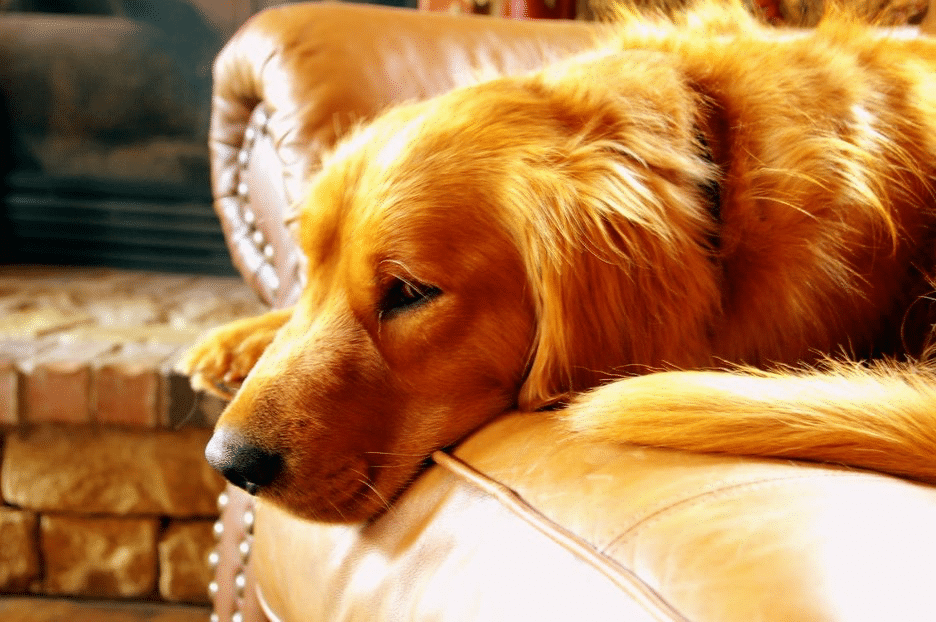
When you have a dog that is struggling with the anxiety of any kind, you have lots of options to help them to have a more enjoyable life and to feel more comfortable. Isolating the reason for the behavior and then taking steps to fix it can make the process of leaving your dog at home alone so much easier. Many dogs can be managed easily, even if they do tend to struggle with this kind of anxiety. Creating a management plan is not as hard as you might think in most cases.
Always remember that your dog is not trying to be bad when they display separation anxiety and try to be patient with them. They are sacred in most cases and worried that you would leave and never come back. Being comforting and patient is important when you are retraining this behavior to improve it. For most Golden Retrievers, a few weeks of work on this kind of problem will lead to an easy resolution that will work for the long haul.
Read more about: Golden Retriever Common Health Issues: Symptoms, Treatments, and Prevention
